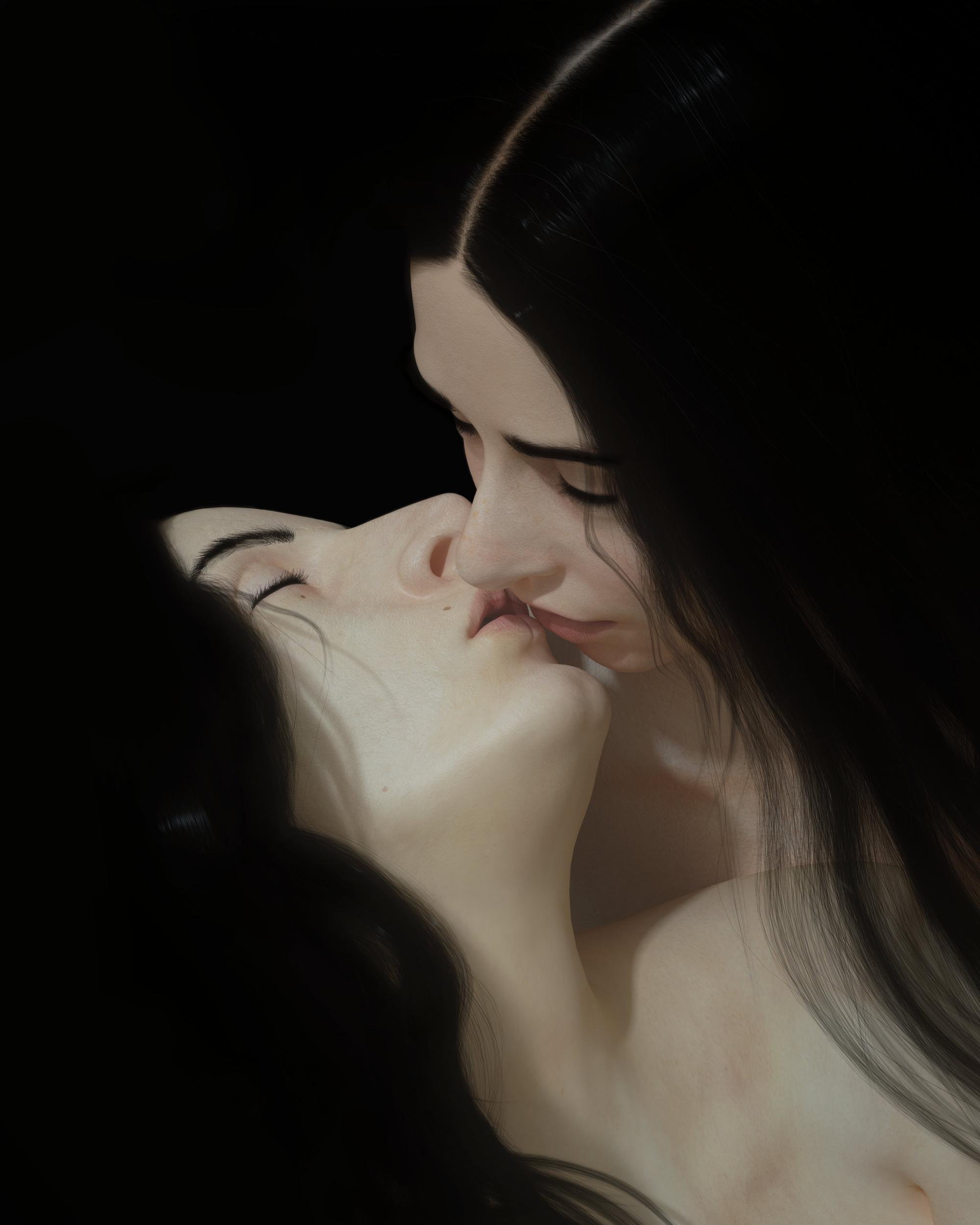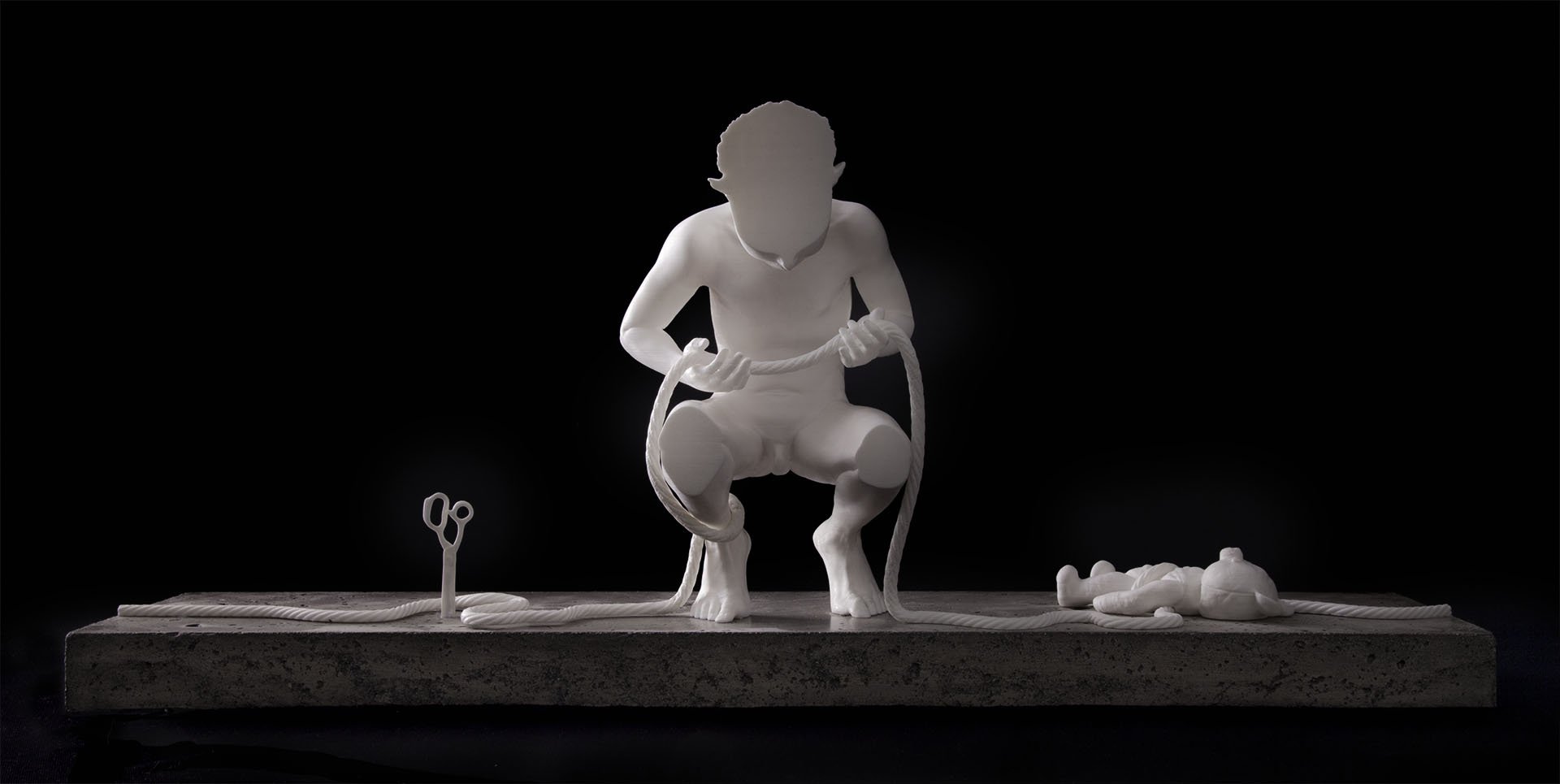Mapping the intimate with Sasha Katz

There's more to a work of art than what's visible. There are silences, threads connecting the work with our inner self, lines of tension and hesitation that we feel, everything that cannot be shown and yet is so essential. Whether realistic or not, the image is a gaze, a frame placed on a world that necessarily goes beyond its narrow limits, making us imagine a larger elsewhere, or a thought, a state of mind. By creating a silence, by choosing a void, we allow the viewer to fill the work with meaning, to make it their own, to connect it to their own experience. In Sasha Katz's images, we find this double function of silence. First, there's the style, with its muted colors, plain backgrounds and tight framing, which frees the imagination by constraining it, allowing it to step out of context and embrace what's important. And then there's the silence of affect, of the intimate, of all these characters, fragile or strong, beautiful and grotesque at the same time, this cartography of feeling declined as the images unfold. Emotions colliding with the masks on the faces.
It's rare to see a 3D artist devote herself to the intimate, and it's even rarer to find here an original, personal angle a world away from the usual clichés. Sasha Katz doesn't explain the scenes she depicts in her images, and they appear curiously abstract to us, as if we're seeing them from afar, from another place, another time. The same faces meet, kiss, make love, wonder, dream perhaps. Nothing much happens, yet everything that makes up the palette of human feelings is expressed. What makes these sober images profoundly complex is precisely the silences that inhabit them, the streams of meaning and emotion that we project onto the work and that it then reflects back to us like a mirror, passed through the prism of the artist's sensibility. Sasha Katz has understood that intimacy is a territory we all travel through, and that art enables us to map this world, to see where our paths converge and where they split.
Sasha Katz's art is vital, not only because it offers a counterpoint to the normalized views of the body in 3D art (which would be a reason in itself, given its over-representation), but also because it shows us the possibility of creating different, personal works. Four years have passed since the release of Sometimes I think about things, and sometimes I get sad, the masterful film by Louis Crevier that paved the way for a new way of looking at 3D, and we can only acknowledge that few artists have followed this road. In the same way that Marc Hericher is an exception in an artistic landscape reluctant to tackle political issues, Sasha Katz is an anomaly in a multitude of artists shying away from the human experience. These isolated experiments are the beginnings of a new 3D art form where artists take risks and assume their sensibility without hiding behind technique, and we can only hope that others will follow in their footsteps.
Sleep Paralysis
Can you tell us a bit about yourself and your background? How did you get into 3D?
I trained as an illustrator and survived the rigors of British higher education. During my studies, I was introduced to Cinema 4D in a series of workshops, but I was so interested in everything at once — like linocut prints, datamoshing, and embroidery — that by the end of studies, I hadn’t found a clear direction. After graduation, I continued searching for my voice and got into pixel art; in fact, my first commissions were pixel GIFs. At a certain point, I decided to add a third dimension to my work, revisiting my Cinema 4D skills from art school and building on them with numerous tutorials. And here I am.
What were you interested in back then, and why this shift towards characters?
I was obsessed with voxels, pastel colors, cel shading, and minimalist GIFs. The main concept centered around the symbiosis of fauna and technology, and I was content with it for quite a while. But eventually, I felt I had explored that aesthetic and concept fully and decided to shift my focus to human figures. The human body had always intrigued me graphically, though I wasn’t sure how to approach it at first. I started experimenting with basic Cinema 4D characters, and around the same time, I discovered Daz 3D, ZBrush bridge, and I got completely absorbed in it.
Initially, I focused on body compositions, but I soon became deeply invested in creating characters, which is now my specialization. I’ve developed 11 characters — 10 female and one male (he was mostly created for fun), and I have 2 more in development. I think of them as actors; I create stories and then decide who fits the role. If no one does, I create a new character specifically for the story. For commissions, I create separate characters that I don’t integrate into my personal work.
Designing faces has become a meditative practice for me. I’ve fallen in love with each character, and when I’m working on one, they’re the first thing on my mind when I wake up, bringing me happiness and fulfillment. But, like in love, it’s impossible to feel the same way forever — so I create new ones.
Sasha Katz
What I love most about your work is the affection you have for your characters. There's a very intimate but never voyeuristic dimension to your images, a gentle look at what they're going through. What do these characters mean to you?
Thank you for saying that! They echo my impressions of remarkable women I’ve encountered, both in person and online. To me, they represent my own diverse and unconventional standards of beauty, which feel like an alternative to the more confusing publicly imposed ones.
Each one has her own distinct appearance, reflecting parts of my identity and voice. The process of bringing them to life is a true joy, and it’s this love that gives them their existence. Without it, they wouldn’t come to be.
In fact, most of your characters are depicted in intimate situations, making love or kissing. I often get the impression that you're interested in the moment when emotions are revealed, when bodies and souls are laid bare. Do you agree with this interpretation?
I do agree with that interpretation and I love it. I've always been drawn to the most dramatic, pivotal moments in poetry and cinema, when emotions are at their peak. These are the moments that feel like a tsunami, when the body, soul, and emotions are fully exposed, ready to either enter paradise, be destroyed, or both.
It’s in these intimate situations — whether making love, sharing a kiss, or even a touch — that the vulnerability of the human experience is most visible.
Sasha Katz
Kiss me quick. We are all dying.
What qualities interest you in the bodies you portray?
I often feel suffocated by the patriarchal beauty standards that surround me, which I find to be quite limiting. For me, beauty is all about diversity, originality, and embracing imperfections. It’s those very imperfections that make a character feel real and unique.
I love to portray characters that challenge conventional norms and celebrate individuality. Each body has its own story to tell, and I want to highlight the uniqueness of every form. My focus is on a wider range of experiences and identities, allowing for a more inclusive representation of what it means to be beautiful.
Sasha Katz
From a stylistic point of view, I find that you evolve at the frontier of several universes. Your work is sometimes close to painting, photography, contemporary art too... What are your inspirations? Do you feel part of any particular artistic movement?
I draw inspiration from a wide range of sources. I’ve been deeply into movies, books, and photography for as long as I can remember, and these influences are definitely reflected in my work. I love grotesque, Mannerism, the films of Béla Tarr, the installations of Jeanne-Claude and Christo, the School of Fontainebleau period, Hannah Wilke’s sculptures, Ukiyo-e woodblock prints, Kobo Abe’s novels, Lucia Berlin’s short stories and Martin Parr photography to name a few. These creators have shaped me, both as an artist and as a person.
As for being part of any artistic movement, I’m not sure I belong to one. I prefer not to limit myself to a specific aesthetic, influenced by the medium I’m using. I feel like I’m speaking the language of photography, using 3d.
I find your attention to detail very interesting. You work a lot with flat colors (the black of the hair that blends into the background, the very plain backgrounds that are almost the same tone as the flesh), yet you always bring in just the right amount of detail to ensure that the image is still realistic. How do you achieve this balance?
It’s very kind of you to say, I really appreciate it! I really love creating images based on neighboring colors or different shades of a single color. I think this comes from my Tumblr days when there was a 2MB size limit for gifs, and one way to reduce the file size was by limiting the color variety.
I approach my work with a balance rooted in painting techniques, deciding what to emphasize and what to simplify, to create harmony between the focal points and surrounding elements. When that harmony is achieved, I feel this inner voice saying, 'Yes, this is it!
Speaking of technique, I'd like you to tell me more about how you work in 3D. What software do you use? What is your relationship with this tool? What does 3D bring to your work compared to other artistic techniques?
I use Daz 3D, ZBrush, Substance Painter, Cinema 4D, and Marvelous Designer (my least favorite software—the logic and algorithms are torturous for me). I keep a list of things I plan to create, each with different priorities. I mostly work in series, as I prefer to express ideas through multiple pieces. Plus, series are more convenient to propose for exhibitions. When a random idea comes to mind, I write it down and revisit it later when I have the time and feel ready.
For me, 3D is all about control: sculpting, posing, composition, lighting—so many options, and only one final choice. Sometimes I end up with multiple variations that are very similar, noticeable mostly to me, which can make decisions really complicated. In those cases, I often ask close friends to help me choose.
What are you working on at the moment? What are your plans for the future?
I'm working on a Japanese horror series, inspired by Hiroshi Teshigahara's films and Japanese horror manga from the 80s. It will consist of 3 to 4 pieces.
I recently moved to Paris, and my future plans include exhibitions, commissions with agencies, and integrating into French culture.
Whispers series













